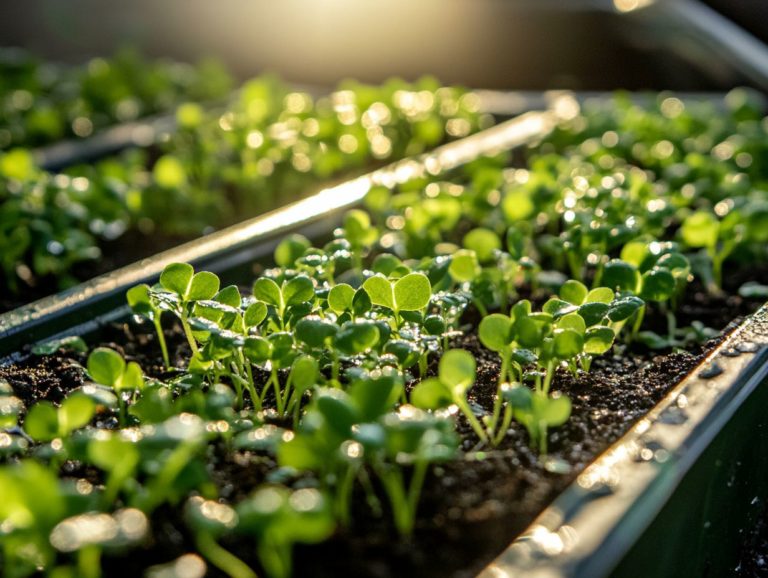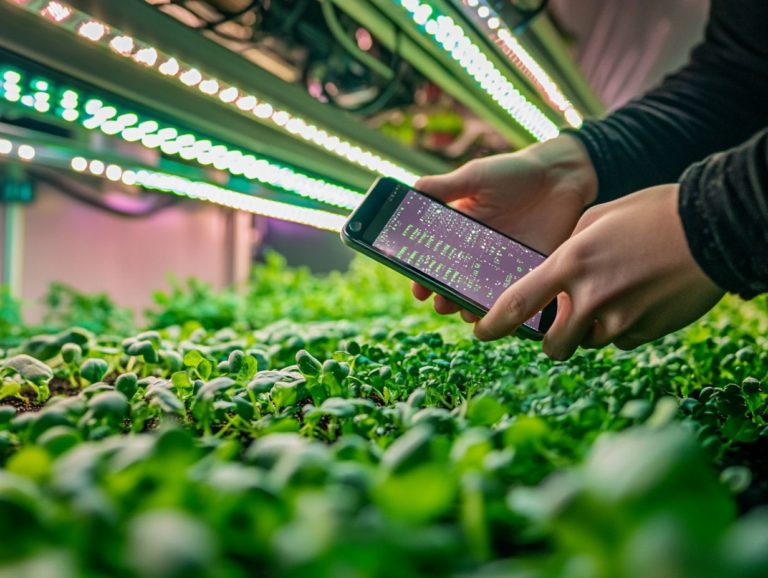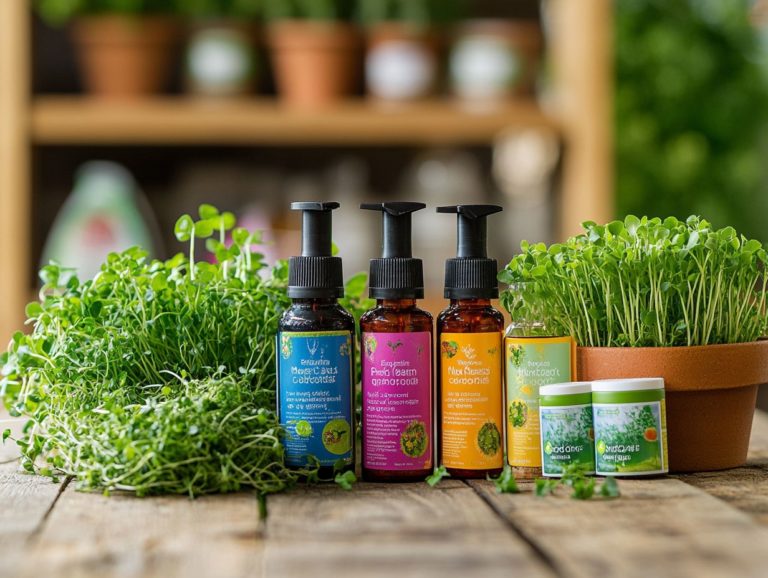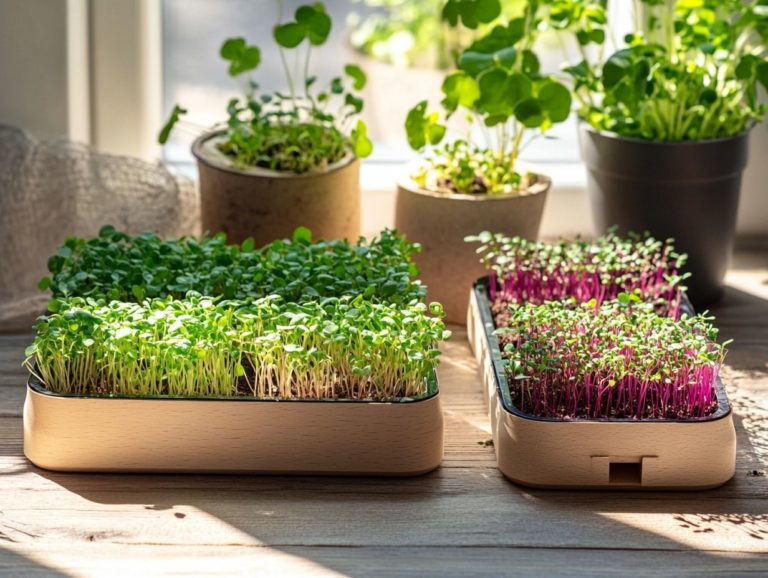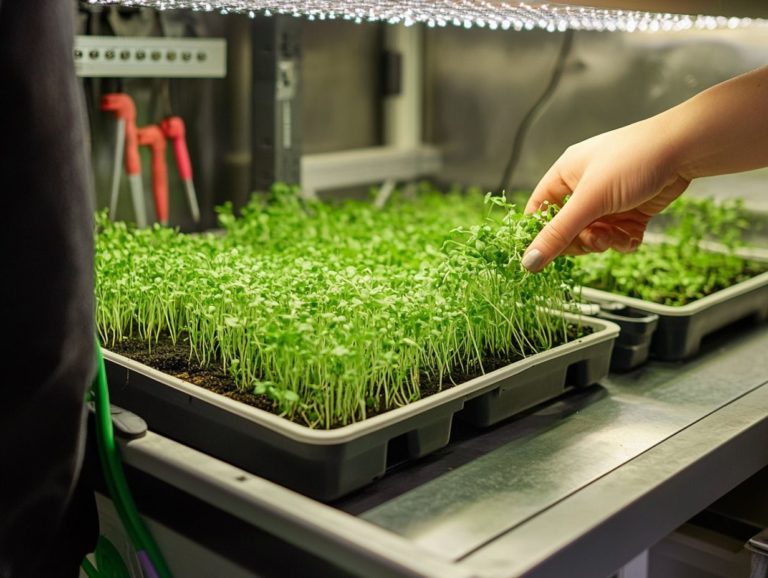Top 10 Accessories for Microgreen Growers
Microgreens are a fantastic way to enhance your gardening experience. They add vibrant flavors and essential nutrients to your dishes.
Having the right accessories can make or break your microgreen garden. This guide highlights the top 10 tools every microgreen enthusiast should consider.
Whether you re just starting or looking to upgrade, these accessories will help you grow lush, healthy greens with ease. Let’s explore how each tool can improve your growing journey!
Contents
- Key Takeaways:
- 1. Grow Trays
- 2. Seedling Heat Mats
- 3. Grow Lights
- 4. Humidity Domes
- 5. pH Testing Kit
- 6. Spray Bottles
- 7. Seed Sprouters
- 8. Plant Markers
- 9. Harvesting Tools
- 10. Microgreen Seeds
- 11. Choosing the Right Accessories
- 11. The Benefits of Using Spray Bottles for Microgreens
- 12. Understanding Different Types of Seed Sprouters
- 13. Why Plant Markers Are Important for Microgreen Growers
- 14. Essential Tools for Harvesting Microgreens
- Frequently Asked Questions
- What are the top 10 must-have accessories for microgreen growers?
- Do I need special growing trays for microgreens?
- Why do microgreens need grow lights?
- Can I reuse my potting soil for multiple batches of microgreens?
- What is the purpose of a humidity dome for microgreens?
- Do I need a fan for my microgreens?
Key Takeaways:
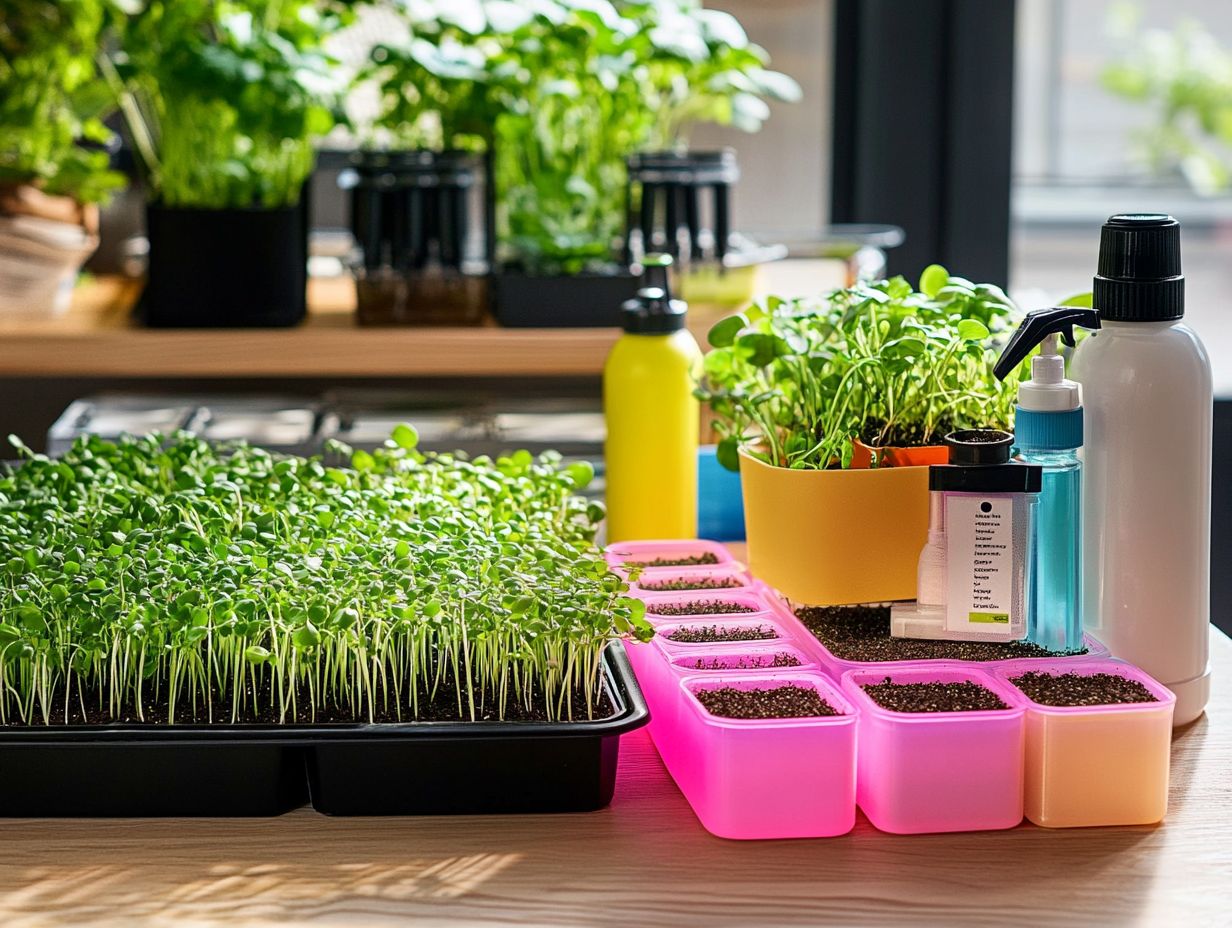
- Invest in high-quality grow trays for effective microgreen growth.
- Use seedling heat mats to maintain the right temperature for your plants.
- Choose suitable grow lights for adequate lighting to promote growth.
1. Grow Trays
Selecting the right grow trays is crucial for your success. They help optimize nutrient absorption and maintain proper moisture and drainage.
Various grow trays are available, ranging from small, shallow trays for delicate plants like mustard greens to deeper trays for those needing more soil. Common materials include plastic and biodegradable options.
Drainage holes are essential to prevent root rot. Shallow trays speed up germination, while deeper trays support robust root systems.
You can easily find trays online or at local suppliers like Gardenary to kickstart your microgreen adventure.
2. Seedling Heat Mats
Seedling heat mats are key to growing microgreens as they create a warm environment that boosts germination. They work best when paired with artificial lights.
These mats maintain a cozy temperature of 70 F to 80 F, vital for seedling development, especially for quick-growing varieties like broccoli and sunflowers. Using mats helps your microgreens sprout quickly and thrive.
Choose reputable brands like VIVOSUN and Hydrofarm for quality and durability. Temperature controllers can further optimize your growing conditions.
3. Grow Lights
Using the right grow lights is vital for indoor microgreen cultivation. They provide the necessary light for plants to make food, promoting robust growth.
LED grow lights are popular for their energy efficiency and adjustable light spectrum, perfect for various microgreens. Alternatively, fluorescent lights are budget-friendly and still offer adequate growth support.
For best results, position the lights 2 to 6 inches above your plants and provide 12 to 16 hours of light daily. Brands like Roleadro and SunBlaster are highly recommended for nurturing vibrant microgreens.
4. Humidity Domes
Humidity domes are vital for growing microgreens. They create a controlled environment that keeps moisture, crucial for healthy seedling development and preventing common issues like damping-off.
Pay attention to moisture levels inside the dome. Keep the soil damp, but not soggy. Check your microgreens daily and gradually introduce fresh air as seedlings sprout.
Once most seeds have germinated, remove the dome. This promotes strong growth and prevents fungal problems. Using plant tags helps you identify various microgreen varieties and cater to their specific needs.
5. pH Testing Kit
A pH testing kit is a must-have for microgreen growers. It allows you to monitor your growing medium’s acidity or alkalinity, which affects nutrient absorption and plant health.
Each microgreen variety has its pH preference, impacting growth and flavor. For instance, arugula enjoys slightly acidic conditions, while basil thrives in neutral soil. Regular testing after watering keeps your soil in the ideal range.
To adjust pH levels, you can use lime to raise them or sulfur to lower them. Investing in a reliable pH meter or testing kit, like those from Bluelab or Hanna Instruments, ensures accurate results for healthy plants.
6. Spray Bottles
Spray bottles are exceptional tools for nurturing microgreens. They provide gentle and even moisture distribution, maintaining ideal humidity without oversaturating the soil especially crucial for delicate seedlings.
Unlike top watering, which can disrupt seedlings, or bottom watering that may lead to waterlogged conditions, spray bottles offer a controlled approach. This minimizes soil displacement and fosters robust root growth.
For the best results, spray in the morning to encourage evaporation throughout the day. Regularly check moisture levels to establish a consistent spraying routine, usually once or twice daily, based on the environment.
7. Seed Sprouters
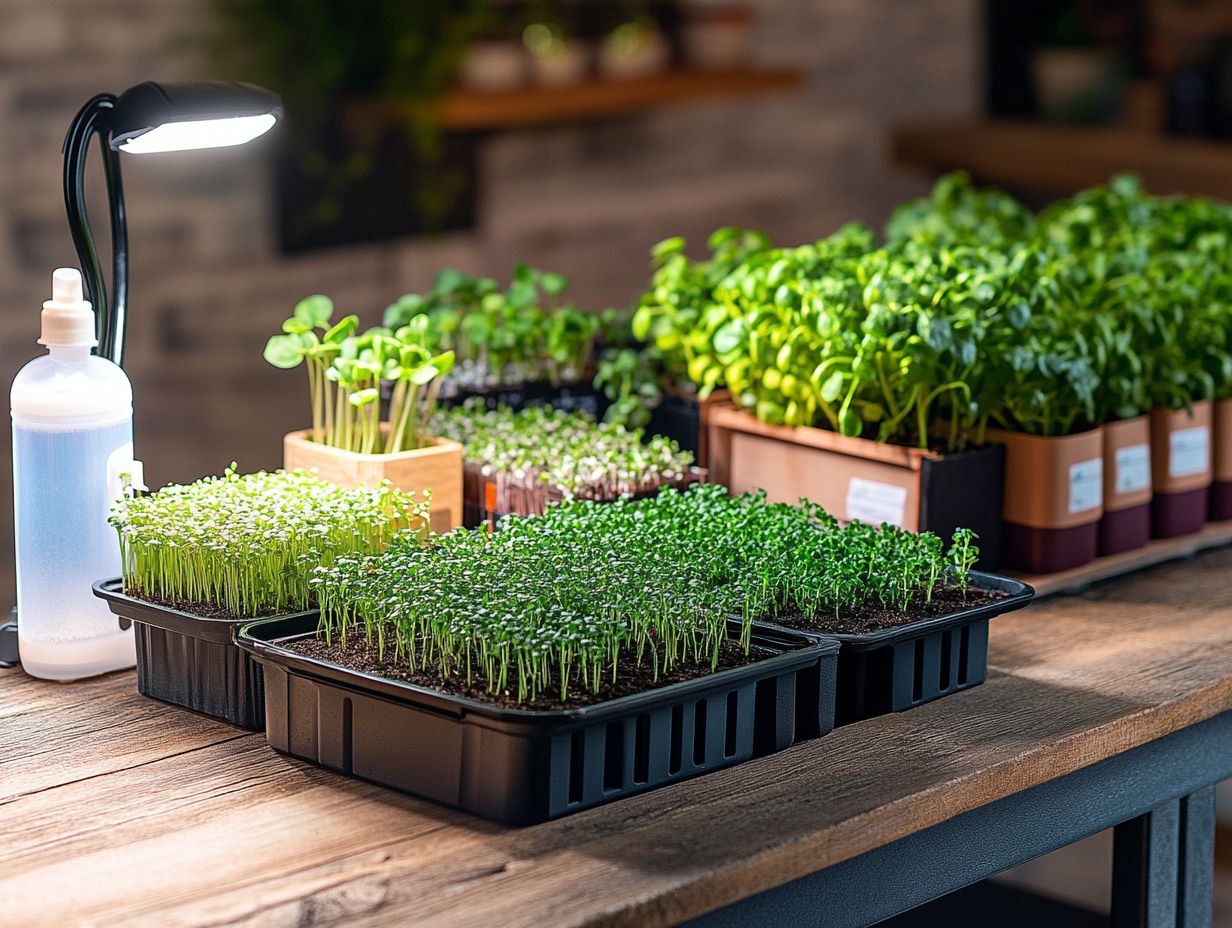
Seed sprouters are specialized containers that make germinating microgreen seeds easy. They are ideal for anyone eager to embrace organic practices in their gardening journey.
With designs ranging from stackable trays to hydroponic systems, these sprouters optimize moisture retention and airflow. Each design serves a distinct purpose, simplifying the germination process.
For the best results, soak your seeds for a few hours before placing them in the sprouter. Popular microgreens like broccoli and sunflower thrive with consistent moisture and indirect light. Check them daily and rinse gently to support steady growth.
By following these straightforward steps, you ll enjoy a bountiful harvest of nutritious greens, even as a novice gardener.
8. Plant Markers
Plant markers are vital for anyone looking into the world of microgreens. They help identify different microgreen seeds and track their growth timelines and care requirements.
As a microgreen enthusiast, you understand that clear labeling is crucial. Accurate plant markers prevent confusion between varieties, ensuring you allocate your resources and attention where they re truly needed.
For example, you might use color-coded tags to distinguish between spicy radish, pea shoots, and basil microgreens, each with its unique growth needs. Simple materials, such as wooden popsicle sticks or biodegradable bamboo stakes, can serve as effective markers.
To craft seed tags that are both informative and durable, consider using waterproof ink to write down plant names, planting dates, and special care instructions. By paying attention to these details, you can boost the health of your plants and elevate your gardening experience.
9. Harvesting Tools
Utilizing the right harvesting tools, like kitchen scissors, is essential for efficiently harvesting microgreens. This ensures that delicate plants are cut cleanly, preserving their roots and surrounding seedlings.
Employing specialized harvesting knives or sharp blades can make a world of difference. A clean cut is crucial for maintaining the integrity and flavor of your greens. Timing is everything; harvesting just before maturity can significantly enhance both yield and taste.
Once you’ve harvested your microgreens, handle them with care. Gentle movements are key to preventing bruising, which helps maintain their vibrant appearance and nutritional quality. To keep your microgreens fresh, use proper storage techniques, like keeping them in cool, dark environments, to extend their freshness.
10. Microgreen Seeds
Choosing the right microgreen seeds is essential for your success. Your options include organic seeds and specialized subscription services that deliver fresh seeds right to your door.
With so many seed varieties available, dive into popular choices like basil, radish, and sunflower. Each brings unique advantages. Basil microgreens not only infuse your dishes with aromatic richness but also boast a wealth of antioxidants. Radish microgreens add a spicy, peppery kick that can elevate any salad to new heights.
You can source these seeds from local suppliers who offer personalized advice or explore online platforms for a broader selection. Subscription services truly shine by allowing you to receive curated, seasonal varieties regularly, ensuring a consistent and diverse supply of fresh seeds throughout the year.
11. Choosing the Right Accessories
Selecting the right accessories for your microgreen garden is vital for optimal growth and simplified maintenance. The right combination of tools can make all the difference in your success.
Consider investing in microgreen trays to enhance your growing space. Among the must-have accessories are grow trays, which provide the ideal depth and drainage for healthy root development.
Choosing the right grow lights is equally important. Grow lights help plants grow indoors by providing the light they need for photosynthesis, even in less-than-ideal lighting conditions.
Humidity domes play a crucial role, creating a controlled microclimate that encourages germination and prevents the soil from drying out too quickly. Imagine turning any small space into a vibrant oasis filled with fresh greens!
What Are the Different Types of Grow Trays Available?
The market presents an impressive array of grow trays tailored specifically for microgreens, including the versatile 1010 and 1020 trays, as well as heavy-duty options designed to endure multiple growing cycles.
Each type of tray comes with unique characteristics that cater to your specific growing needs. The compact 1010 trays are perfect for home growers with limited space, allowing you to cultivate smaller batches of delicate microgreens effortlessly. To enhance your growing experience, consider the top 10 grow lights for microgreens in 2024.
In contrast, the more expansive 1020 trays provide ample room for extensive planting, enabling you to explore a wider variety of greens all at once. If durability is your priority, the heavy-duty options elevate your growing experience.
These trays not only facilitate efficient water management but also promote excellent air circulation, both essential for the health and rapid growth of microgreens. For those interested in sourcing the best seeds, check out the top 7 seed suppliers for microgreens. This attention to detail ultimately leads to better yields and vibrant flavors that will enhance your culinary creations.
How Can Seedling Heat Mats Help with Microgreen Growth?
Seedling heat mats create a controlled environment. This helps maintain the ideal temperature for seed germination and boosts early microgreen growth.
When using heat mats, pair them with LED grow lights for the best results. This combination significantly increases your chances of a successful crop.
These mats evenly warm the soil or planting trays, providing a stable foundation for your seedlings. Aim for a temperature between 65 F and 75 F, depending on the specific microgreen variety.
Fast-growing varieties like radishes and mustard greens thrive at the warmer end of the scale. Others may prefer slightly cooler conditions.
Consistent warmth not only speeds up germination but also strengthens root systems. This ultimately results in healthier plants and better yields.
What Are the Different Types of Grow Lights and Their Benefits?

There are various types of grow lights for indoor microgreens, including LED and fluorescent bulbs. Each type has unique advantages that enhance the growth and health of your plants.
Choose grow lights based on your setup and specific needs. For example, LED lights are energy-efficient and provide a full spectrum of light, although they require a higher initial investment.
On the other hand, fluorescent bulbs are budget-friendly and work well in smaller spaces. However, they may not deliver the intensity or light spectrum needed for certain nutrient-rich plants.
Understanding how each type works helps you create an optimal indoor environment. This ensures your microgreens thrive and are packed with essential nutrients.
Why Do You Need a Humidity Dome for Your Microgreens?
A humidity dome is an important tool for microgreens growers. It retains moisture during the germination phase, ensuring your seeds sprout and develop optimally.
These domes create a mini greenhouse effect that maintains consistent humidity levels. This is especially beneficial for seeds that thrive in moist conditions, like basil and cilantro.
During the first week after sowing, humidity domes are essential for successful germination. Once your young plants emerge, gradually remove the dome to help them adapt to lower humidity and prevent mold growth.
Careful use of humidity domes nurtures healthier seedlings. This boosts the overall yield and quality of your microgreen varieties.
How Can a pH Testing Kit Help with Microgreen Growth?
A pH testing kit helps you monitor the ideal pH levels in your growing medium. This is crucial for nutrient absorption and healthy microgreen growth.
Regular checks allow you to quickly spot any issues that may hinder plant development. Each microgreen has its preferred pH range; for instance, radish microgreens thrive in slightly acidic conditions, while basil grows best in neutral pH.
Keeping pH levels precise not only benefits plant health but also enhances flavor and nutrition. If adjustments are needed, use pH up or down solutions to fine-tune your growing medium for a more plentiful harvest.
11. The Benefits of Using Spray Bottles for Microgreens
Spray bottles are essential for caring for your microgreens. They provide gentle watering, maintaining moisture without overwhelming delicate seedlings.
This method promotes healthy growth and reduces soil erosion. A fine mist ensures even water distribution, minimizing runoff that can wash away valuable nutrients.
To achieve the best results, adjust your watering frequency. This keeps the soil structure intact and supports sustainable gardening practices that benefit you and the environment.
12. Understanding Different Types of Seed Sprouters
Seed sprouters come in various models designed for efficient microgreen seed germination. They’re a must-have for anyone committed to organic gardening.
From basic tray systems to advanced automated kits, each sprouter has unique features to meet your needs. Some have deep trays with ventilation holes for optimal airflow, while others include built-in water reservoirs for maintaining moisture.
Consider factors like ease of cleaning and material quality when choosing a sprouter. These elements contribute to successful germination and vibrant microgreens, making your gardening journey rewarding and fruitful.
13. Why Plant Markers Are Important for Microgreen Growers
Plant markers are essential for you as a microgreen grower. They help you keep track of the seed varieties you ve planted and their growth stages. This ensures you provide the proper care throughout the entire growing process.
You ll find these markers in a variety of forms, such as wooden stakes, plastic tags, and metal labels. Each has its own set of advantages. Wooden markers bring a rustic charm to your setup and are biodegradable. Plastic options are durable and moisture-resistant, so they won t break down quickly when exposed to water. Metal markers are celebrated for their longevity; they resist rust and can be reused across different planting seasons.
Seed tags are particularly important for organizing and identifying your various microgreen types. This makes the growing process smoother and more efficient. With clear labeling, you can easily distinguish between different varieties, leading to better management and ultimately a more fruitful harvest.
14. Essential Tools for Harvesting Microgreens
Having the right harvesting tools, like kitchen scissors, is crucial for harvesting microgreens. A clean cut keeps your plants thriving!
Along with scissors, you might want to explore specialized microgreen knives or small harvesting blades. These tools offer precision while minimizing damage to nearby shoots.
Cutting microgreens just above the soil level is a smart move. It helps maintain the integrity of the root system, encouraging potential regrowth for future harvests.
Harvest during cooler times to unlock the full flavor potential of your microgreens. This practice enhances both the flavor profile and shelf life, allowing their natural sweetness to shine while keeping them crisp and vibrant for longer.
Frequently Asked Questions

What are the top 10 must-have accessories for microgreen growers?
- Grow trays
- Grow lights
- Seeds
- Potting soil
- Watering can or spray bottle
- Plant labels
- Humidity dome
- Scissors
- Fan
- Timer
Do I need special growing trays for microgreens?
Yes, it is recommended to use shallow grow trays specifically designed for microgreens. These trays allow for proper drainage and air circulation, essential for successful microgreen growth.
Why do microgreens need grow lights?
Microgreens require grow lights because they have a short growth period and need a lot of light to thrive. Indoor lighting may not be enough, so using grow lights ensures that your microgreens receive the proper amount of light for healthy growth.
Can I reuse my potting soil for multiple batches of microgreens?
No, it is not recommended to reuse potting soil for multiple batches of microgreens. Used soil may contain harmful bacteria or depleted nutrients, affecting the growth and health of your microgreens.
What is the purpose of a humidity dome for microgreens?
A humidity dome is a clear cover that keeps moisture in, helping young plants grow. This is especially helpful during the initial growth stages when the microgreens are delicate and need a higher level of humidity.
Do I need a fan for my microgreens?
Yes, a fan is important for air circulation. It can help prevent mold and other diseases from forming on your microgreens. Additionally, it helps strengthen the stems of your microgreens, resulting in healthier and stronger plants.
Ready to start your microgreen journey? Get your supplies and grow your greens today!


